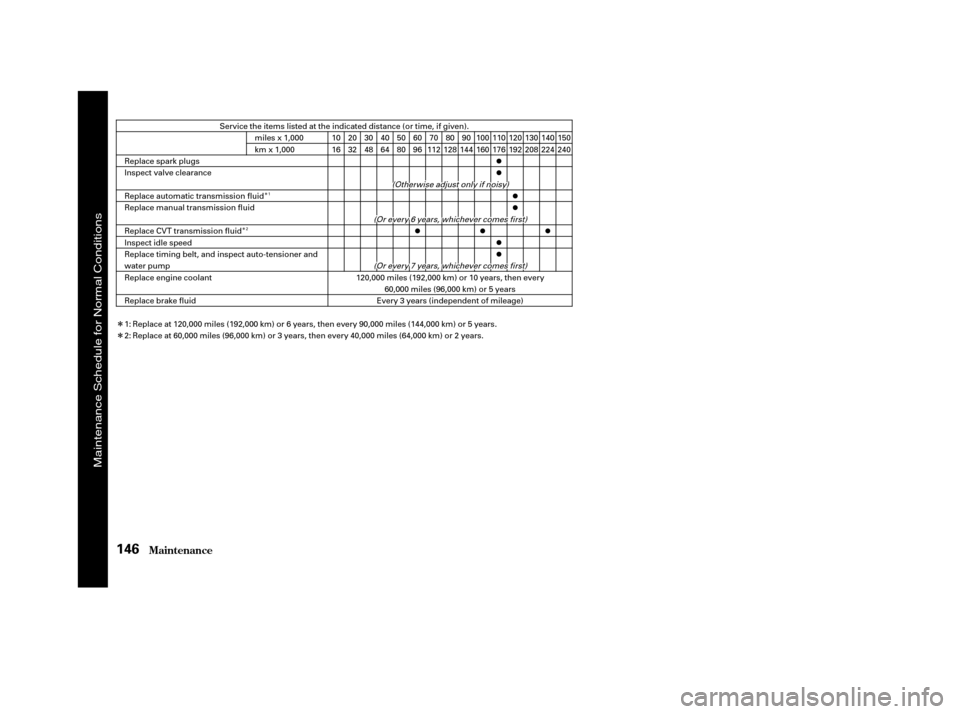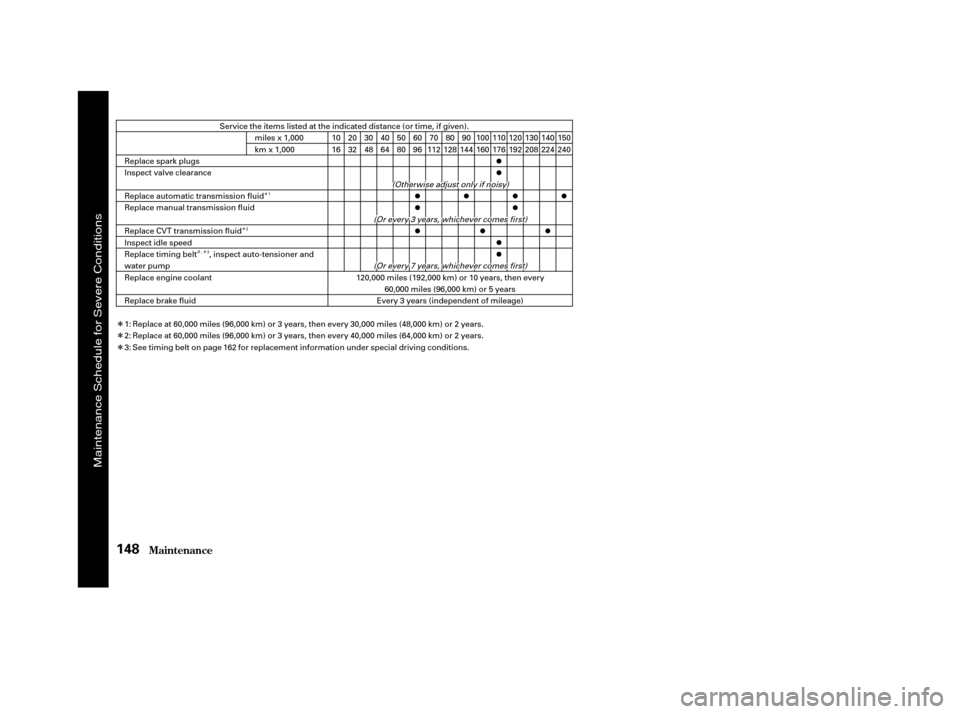Page 133 of 231
Honda’s Continuously Variable
Transmission’s unique design
provides a smooth, constant f low of
power. It is electronically controlled
f or more precise operation and
better f uel economy.These indicators on the instrument
panel show which position the shif t
lever is in.
The ‘‘D’’ indicator comes on f or a
f ew seconds when you turn the
ignition switch to ON (II). If it
f lashes while driving (in any shif t
position), it indicates a possible
problem in the transmission. Avoid
rapid acceleration and have the trans-
mission checked by a Honda dealer
as soon as possible.To shif t f rom any position, press the
releasebuttononthefrontof the
shiftlever.Youcannotshiftoutof
Park when the ignition switch is in
LOCK (0) or ACCESSORY (I).
On HX model
Automatic Transmission (CVT)
Driving
Continuously Variable
T ransmission (CVT )
Shif t L ever Position Indicators Shif ting
134
RELEASE BUTTONSHIFT LEVER
�����—�����—�����y�
�������������y���
�(���%�������y���
�����y
Page 134 of 231

�µ
�µ �µTo shift from:
PtoR
RtoP
NtoR StoL
LtoS
StoD
DtoS
DtoN
NtoD RtoN Do this:
Press the brake pedal and
press the release button.
Press the release button.
Move the lever.To shift from Re-
verse to Park, see the explanation
under Park. To shif t to Reverse f rom
Neutral, come to a complete stop
first. Press the release button before
shifting into Reverse from Neutral.
This position mechani-
cally locks the transmission. Use
Park whenever you are turning of f or
starting the engine. To shif t out of
Park, you must press on the brake
pedal and have your f oot of f the
accelerator pedal.
If you have done all of the above and
still cannot move the lever out of
Park, see on
page . To avoid transmission damage, come
to a complete stop bef ore shif ting
into Park. The shif t lever must be in
Park bef ore you can remove the key
from the ignition switch.
Use Neutral if you
need to restart a stalled engine, or if
it is necessary to stop brief ly with
the engine idling. Shif t to the Park
position if you need to leave your
vehicle for any reason. Press on the
brake pedal when you are moving
the shift lever from Neutral to
another gear.
133
CONT INUED
Automatic Transmission (CVT)
Driving
Reverse (R)
Park (P) Shif t L ock Release Neutral (N)
135
�����—�����—�����y�
�������������y���
�(���%�������y���
�����y
Page 135 of 231

�µ�µ�µUse this position f or
your normal driving. The
transmission automatically adjusts to
keep the engine at the best speed f or
driving conditions. To help the
engine warm up f aster, the
transmission will select ratios that
allow the engine to run at higher
speedswhenitiscold. To shif t to Low, press
the release button on the front of the
shif t lever. Use Low to get more
power when climbing, and f or
maximum engine braking when
going down steep hills.
Selecting Second
shifts the transmission into a lower
range of ratios for better
acceleration and increased engine
braking. Use Second when you are
going down a steep hill, or in stop-
and-go driving. ForfasteraccelerationwheninD,S
or L, the transmission will
automatically ‘‘kick down’’ to a lower
range of ratios by pushing the
accelerator pedal to the floor.The CVT shifts automatically to
maintain proper engine speed in any
shif t position.
When the vehicle reaches the
maximum speed in any shif t position,
you may f eel the engine cut in and
out. This is caused by a limiter (112
mph, 180 km/h) in the engine’s
computer controls. The engine will
run normally when you reduce the
speed to below the maximum.
Automatic Transmission (CVT)
Driving
Drive (D) L ow (L ) Maximum Allowable Speeds
Second (S)
136
�����—�����—�����y�
���������
���y���
�(���%�������y���
�����y
Page 136 of 231

Always use the parking brake when
you park your vehicle. Make sure
the parking brake is set f irmly or
your vehicle may roll if it is on an
incline.Make sure the moonroof and the
windows are closed.
Turn of f the lights.
Place any packages, valuables, etc.
in the trunk or take them with you.
Lock the doors.
If your vehicle has an automatic
transmission, set the parking brake
bef ore you put the transmission in
Park. This keeps the vehicle f rom
moving and putting pressure on the
parking mechanism in the
transmission.
Never park over dry leaves, tall
grass, or other f lammable
materials. The hot three way
catalytic converter could cause
these materials to catch on fire.If the vehicle is f acing uphill, turn
the f ront wheels away f rom the
curb. If you have a manual
transmission, put it in f irst gear.
If the vehicle is f acing downhill,
turn the front wheels toward the
curb. If you have a manual
transmission, put it in reverse gear.
Make sure the parking brake is
f ully released bef ore driving away.
Driving with the parking brake
partially set can overheat or
damage the rear brakes.
Driving
Parking T ips
Parking
137
�����—�����—�����y�
�������������y���
�(���%�������y���
�����y
Page 140 of 231

This section explains why it is
important to keep your vehicle well
maintained and how to f ollow basic
maintenance saf ety precautions.
This section also includes
Maintenance Schedules f or normal
driving and severe driving conditions,
a Maintenance Record, and instruc-
tions f or simple maintenance tasks
you may want to take care of
yourself .
If you have the skills and tools to per-
f orm more complex maintenance
tasks on your Honda, you may want
to purchase the Service Manual. See
page f or inf ormation on how to
obtain a copy, or see your Honda
dealer.......................
Maintenance Saf ety . 142
.................
Maintenance Schedule . 143
....................
Maintenance Record . 149
..............................
Fluid Locations . 151
........................
Adding Engine Oil . 152
.........
Changing the Oil and Filter . 154
....................
Windshield Washers . 156
..............................
Engine Coolant . 157
....................
Power Steering Fluid . 159
....
Automatic Transmission Fluid . 160
........
Manual Transmission Fluid . 162
....................................
Timing Belt . 162
................
Brake and Clutch Fluid . 163
.............................................
Lights . 164
.......................................
Seat Belts . 169
.....................................
Floor Mats . 169
..................
Dust and Pollen Filter . 169
.................................
Wiper Blades . 170
...............................................
Tires . 172
...................
Checking the Battery . 178
.............................
Vehicle Storage . 179
221
Maintenance
Maint enance141
�����—�����—�����y�
�������������y���
�(���%�������y���
�����y
Page 143 of 231

�µ�µ�µ
�µ
�µ
�µ
�Ì
Your authorized Honda dealer
knows your vehicle best and can
provide competent, ef f icient service.
However, service at a dealer is not
mandatory to keep your warranties
in effect. Maintenance may be done
by any qualif ied service f acility or
skilled person to keep your warranty
in ef f ect. Keep all the receipts as
proof of completion, and have the
person who does the work f ill out the
Maintenance Record. Check your
warranty booklet f or more
inf ormation. Engine oil level Check every
time you fill the fuel tank. See
page .
Engine coolant level Check the
radiator reserve tank every time
you f ill the f uel tank. See page .
Automatic transmission Check
the f luid level monthly. See page
.
Brakes Check the f luid level
monthly. See page .
Tires Check the tire pressure
monthly. Examine the tread f or
wear and foreign objects. See page .
Lights Check the operation of
the headlights, parking lights,
taillights, high-mount brake light,
and license plate lights monthly.
See page .
U.S. Vehicles:
According to state and federal
regulations, f ailure to perf orm
maintenance on the items marked
with will not void your emissions
warranties. However, Honda
recommends that all maintenance
services be perf ormed at the
recommended time or mileage
period to ensure long-term reliability.
Youshouldcheckthefollowing
items at the specif ied intervals. If
you are unsure of how to perf orm
any check, turn to the appropriate
page listed.
We recommend the use of Honda
parts and f luids whenever you have
maintenance done. 117
118
160 163
172
164
Maintenance Schedule
Maint enance
Maintenance, replacement, or
repair of emissions control
devices and systems may be done
by any automotive repair
establishment or individual using
parts that are ‘‘certif ied’’ to EPA
standards.
Owner’s Maintenance Checks
144
�����—�����—�����y�
������
������y���
�(���%�������y���
�����y
Page 145 of 231

�Î �Î�Î
�Î
Maint enance146
miles x 1,000
km x 1,000
Service the items listed at the indicated distance (or time, if given).
10162032304840645080 70
112 80
128 90
144
6096 110176
((OOtthheerrwwiisseeaaddjjuussttoonnllyyiiffnnooiissyy))
((OOrreevveerryy66yyeeaarrss,,wwhhiicchheevveerrccoommeessffiirrsstt))
((OOrreevveerryy77yyeeaarrss,,wwhhiicchheevveerrccoommeessffiirrsstt))
Every 3 years (independent of mileage)
120,000 miles (192,000 km) or 10 years, then every
60,000 miles (96,000 km) or 5 years 120 192
130208 140224150240
100160
Replace spark plugs
Inspect valve clearance
Replace automatic transmission fluid
Replace manual transmission fluid
Replace CVT transmission fluid
Inspect idle speed
Replace timing belt, and inspect auto-tensioner and
water pump
Replace engine coolant
Replace brake fluid
Replace at 60,000 miles (96,000 km) or 3 years, then every 40,000 miles (64,000 km) or 2 years.
Replace at 120,000 miles (192,000 km) or 6 years, then every 90,000 miles (144,000 km) or 5 years.
1: 2: 1
2
Maintenance Schedule for Normal Conditions
�����—�����—�����y�
���������
���y���
�(���%�������y���
�����y
Page 147 of 231

�Î
�Î
�Ì�Î
�Î �Î�Î
Maint enance148
miles x 1,000
km x 1,000
Service the items listed at the indicated distance (or time, if given).
Replace spark plugs
Inspect valve clearance
Replace automatic transmission fluid
Replace manual transmission fluid
Replace CVT transmission fluid
Inspect idle speed
Replace timing belt , inspect auto-tensioner and
water pump
Replace engine coolant
Replace brake fluid 10 16
((OOtthheerrwwiisseeaaddjjuussttoonnllyyiiffnnooiissyy))
((OOrreevveerryy33yyeeaarrss,,wwhhiicchheevveerrccoommeessffiirrsstt))
((OOrreevveerryy77yyeeaarrss,,wwhhiicchheevveerrccoommeessffiirrsstt))120,000 miles (192,000 km) or 10 years, then every
60,000 miles (96,000 km) or 5 years
Every 3 years (independent of mileage)
20 32
304840645080609670
112 80
128 90
144 100160 120192130208 140224
110176 150240
See timing belt on page for replacement information under special driving conditions.
Replace at 60,000 miles (96,000 km) or 3 years, then every 40,000 miles (64,000 km) or 2 years.
Replace at 60,000 miles (96,000 km) or 3 years, then every 30,000 miles (48,000 km) or 2 years.
1:2:
3: 162 1
2
,3
Maintenance Schedule for Severe Conditions
�����—�����—�����y�
�������������y���
�(���%�������y���
���
�y